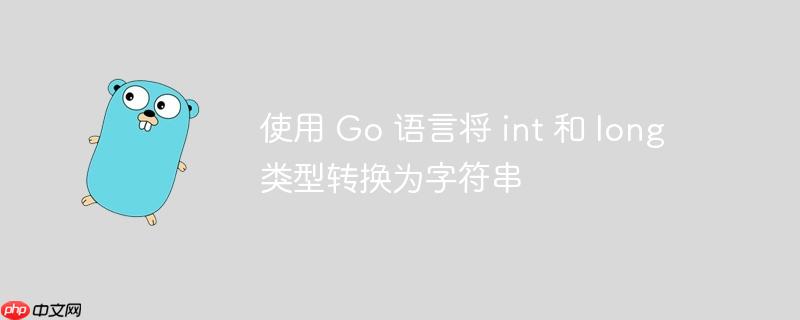
本文介绍了如何在 Go 语言中将 int 和 int64 (long) 类型的数据转换为字符串,以便在并发程序中构建包含数字和时间信息的字符串。文章提供了使用 strconv 包的 Itoa 和 FormatInt 函数的示例,并强调了 Go 1 版本后 Itoa64 被 FormatInt 替代的更新。
在 Go 语言中,经常需要在字符串中嵌入数字类型的数据,尤其是在并发程序中,可能需要将整数、时间戳等信息组合成字符串进行传递。Go 语言的标准库 strconv 包提供了方便的函数来实现这些转换。
strconv.Itoa 函数可以将 int 类型的数据转换为对应的字符串表示。这在构建包含整数的字符串时非常方便。
package main
import (
"fmt"
"strconv"
)
func main() {
number := 123
str := "The number is: " + strconv.Itoa(number)
fmt.Println(str) // Output: The number is: 123
}在上面的例子中,strconv.Itoa(number) 将整数 123 转换为字符串 "123",然后将其与字符串 "The number is: " 连接起来。
对于 int64 类型的数据(通常用于表示时间戳等),可以使用 strconv.FormatInt 函数将其转换为字符串。该函数需要两个参数:要转换的 int64 值和基数(base)。常用的基数是 10,表示十进制。
package main
import (
"fmt"
"strconv"
"time"
)
func main() {
timestamp := time.Now().UnixNano()
str := "Timestamp: " + strconv.FormatInt(timestamp, 10)
fmt.Println(str) // Output: Timestamp: 1678886400000000000 (示例)
}在这个例子中,time.Now().UnixNano() 获取当前时间的纳秒级时间戳,类型为 int64。然后,strconv.FormatInt(timestamp, 10) 将其转换为十进制字符串。
在并发程序中,需要特别注意字符串构建的效率和线程安全。以下是一个简单的示例,展示如何在并发的 goroutine 中构建包含数字和时间信息的字符串,并通过 channel 传递:
package main
import (
"fmt"
"strconv"
"time"
)
func routine1(out chan<- string) {
for i := 0; i < 30; i++ {
timestamp := time.Now().UnixNano()
message := "Message " + strconv.Itoa(i) + " at " + strconv.FormatInt(timestamp, 10)
out <- message
time.Sleep(time.Millisecond * 100) // 模拟一些工作
}
close(out) // 关闭 channel,通知 routine2 结束
}
func routine2(in <-chan string) {
for str := range in {
fmt.Println(str)
}
}
func main() {
out := make(chan string)
go routine1(out)
routine2(out)
}在这个例子中,routine1 负责生成包含循环计数器和时间戳的字符串,并通过 channel out 发送。routine2 负责从 channel 接收字符串并打印。
注意事项:
strconv 包提供了强大的数字类型到字符串类型的转换功能。strconv.Itoa 用于将 int 转换为字符串,而 strconv.FormatInt 用于将 int64 转换为字符串。在并发程序中,合理使用这些函数,并注意字符串构建的效率和 channel 的正确关闭,可以有效地构建包含数字和时间信息的字符串。
以上就是使用 Go 语言将 int 和 long 类型转换为字符串的详细内容,更多请关注php中文网其它相关文章!

每个人都需要一台速度更快、更稳定的 PC。随着时间的推移,垃圾文件、旧注册表数据和不必要的后台进程会占用资源并降低性能。幸运的是,许多工具可以让 Windows 保持平稳运行。

Copyright 2014-2025 https://www.php.cn/ All Rights Reserved | php.cn | 湘ICP备2023035733号